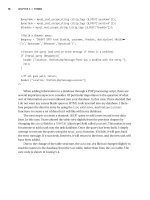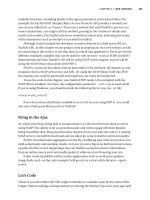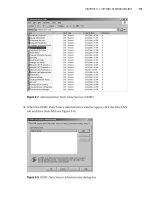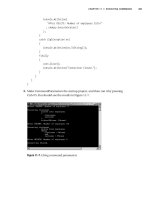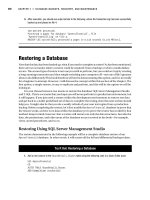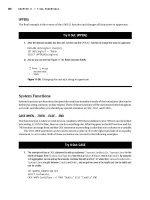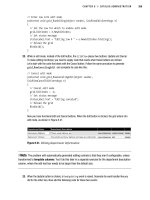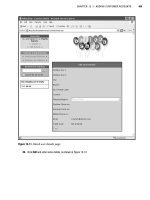Beginning Java SE 6 Platform From Novice to Professional phần 5 pptx
Bạn đang xem bản rút gọn của tài liệu. Xem và tải ngay bản đầy đủ của tài liệu tại đây (466.58 KB, 51 trang )
public Locale Returns a fallback locale for further resource bundle
getFallbackLocale(String baseName, searches (via ResourceBundle.getBundle()). A
Locale locale) NullPointerException is thrown if baseName or locale
is null.
public List<String> Returns a list of strings that identify the formats to be
getFormats(String baseName) used in loading resource bundles that share the given
baseName. A NullPointerException is thrown if
baseName is null.
public static final Returns a ResourceBundle.Control whose
ResourceBundle.Control getFormats() method returns the specified formats,
getNoFallbackControl(List<String> and whose getFallBackLocale() method returns
formats) null. A NullPointerException is thrown if the formats
list is null. An IllegalArgumentException is thrown if
the list of formats is not known.
public long Returns the time-to-live value for resource bundles
getTimeToLive(String baseName, loaded via this ResourceBundle.Control. A
Locale locale) NullPointerException is thrown if baseName or locale
is null.
public boolean Determines if the expired cached bundle needs to be
needsReload(String baseName, reloaded by comparing the last modified time with
Locale locale, String format, loadTime. It returns a true value (the bundle needs to
ClassLoader loader, ResourceBundle be reloaded) if the last modified time is more recent
bundle, long loadTime) than the loadTime. A NullPointerException is thrown
if baseName, locale, format, loader, or bundle is null.
public ResourceBundle Creates a new resource bundle based on a
newBundle(String baseName, combination of baseName and locale, and taking the
Locale locale, String format, format and loader
into consideration. A
ClassLoader loader, boolean reload) NullPointerException is thrown if baseName, locale,
format, or loader is null (or if toBundleName(), which
is called by this method, returns null). An
IllegalArgumentException is thrown if format is not
known or if the resource identified by the given
parameters contains malformed data. A
ClassCastException is thrown if the loaded class
cannot be cast to ResourceBundle. An
IllegalAccessException is thrown if the class or its
empty constructor is not accessible. An
InstantiationException is thrown if the class cannot
be instantiated for some other reason. An
ExceptionInInitializerError is thrown if the class’s
static initializer fails. A SecurityException is thrown if
a security manager is present and disallows
instantiation of the resource bundle class.
public String Converts the specified baseName and locale into a
toBundleName(String baseName, bundle name whose components are separated by
Locale locale) underscore characters. For example, if baseName is
MyResources and locale is en, the resulting bundle
name is MyResources_en. A NullPointerException is
thrown if baseName or locale is null.
CHAPTER 5 ■ INTERNATIONALIZATION 181
Continued
Method Description
830-X CH05.qxd 9/18/07 9:24 PM Page 181
public final String Converts the specified bundleName to a resource name.
toResourceName(String bundleName, Forward-slash separators replace package period
String suffix) separators; a period followed by suffix is appended
to the resulting name. For example, if bundleName is
com.company.MyResources_en and suffix is
properties, the resulting resource name is
com/company/MyResources_en.properties. A
NullPointerException is thrown if bundleName or
suffix is null.
The getCandidateLocales() method is called by a ResourceBundle.getBundle() factory
method each time the factory method looks for a resource bundle for a target locale. You
can override
getCandidateLocales() to modify the target locale’s parent chain. For exam-
ple, if you want your Hong Kong resource bundles to share traditional Chinese strings,
make Chinese/Taiwan resource bundles the parent bundles of Chinese/Hong Kong
resource bundles. The Java Tutorial’s “Customizing Resource Bundle Loading” lesson
(
shows how to
accomplish this task.
The
getFallbackLocale() method is called by a ResourceBundle.getBundle() factory
method each time the factory method cannot find a resource bundle based on
getFallbackLocale()’s baseName and locale arguments. You can override this method
to return null if you do not want to continue a search using the default locale.
The
getFormats() method is called by a ResourceBundle.getBundle() factory method
when it needs to load a resource bundle that is not found in the cache. This returned
list of formats determines if the resource bundles being sought during the search are
class files only, properties files only, both class files and properties files, or some other
application-defined formats. When you override
getFormats() to return application-
defined formats, you will also need to override
newBundle() to load bundles based
on these formats. Check out Sun’s “Customizing Resource Bundle Loading with
ResourceBundle.Control” Tech Tip (
/>2005/tt1018.html#2) for an example.
Earlier, I demonstrated using
clearCache() to remove all resource bundles from
ResourceBundle’s cache. Rather than explicitly clear the cache, you can control how long
resource bundles remain in the cache before they need to be reloaded, by using the
getTimeToLive() and needsReload() methods. The getTimeToLive() method returns one
of the following:
• A positive value representing the number of milliseconds that resource bundles
loaded under the current
ResourceBundle.Control can remain in the cache without
being validated against their source data
CHAPTER 5 ■ INTERNATIONALIZATION182
Table 5-6. Continued
Method Description
830-X CH05.qxd 9/18/07 9:24 PM Page 182
• 0 if the bundles must be validated each time they are retrieved from the cache
•
ResourceBundle.Control.TTL_DONT_CACHE if the bundles are not cached
• The default
ResourceBundle.Control.TTL_NO_EXPIRATION_CONTROL if the bundles are
not to be removed from the cache under any circumstance (apart from low mem-
ory, or if you explicitly clear the cache)
If a
ResourceBundle.getBundle() factory method finds an expired resource bundle in
the cache, it calls
needsReload() to determine if the resource bundle should be reloaded.
If this method returns true, the factory method removes the expired resource bundle
from the cache; a false return value updates the cached resource bundle with the time-
to-live value returned from
getTimeToLive().
The
toBundleName() method is called from the default implementations of
needsReload() and newBundle() when they need to convert a base name and a locale to
a bundle name. You can override this method to load resource bundles from different
packages instead of the same package. For example, assume that
MyResources.properties
stores your application’s default (base) resource bundle, and that you also have a
MyResources_de.properties file for storing your application’s German language resources.
The default implementation of
ResourceBundle.Control organizes these bundles in the
same package. By overriding
toBundleName() to change how these bundles are named,
you can place them into different packages. For example, you could have a
com.company.
app.i18n.base.MyResources package corresponding to the com/company/app/i18n/base/
MyResources.properties resource file, and a com.company.app.i18n.de.MyResources package
corresponding to the
com/company/app/i18n/de/MyResources.properties file. You can learn
how to do this by exploring a similar example in Sun’s “International Enhancements in
Java SE 6” article (
/>Although you will often subclass
ResourceBundle.Control and override some combi-
nation of the callback methods, this isn’t always necessary. For example, if you want to
restrict resource bundles to class files only or to properties files only, you can invoke
getControl() to return a ready-made ResourceBundle.Control (thread-safe singleton)
object that takes care of this task. To get this object, you will need to pass one of the
following
ResourceBundle.Control constants to getControl():
•
FORMAT_PROPERTIES, which describes an unmodifiable List<String> containing
"java.properties"
• FORMAT_CLASS, which describes an unmodifiable List<String> containing
"java.class"
• FORMAT_DEFAULT, which describes an unmodifiable List<String> containing
"java.class" followed by "java.properties"
CHAPTER 5 ■ INTERNATIONALIZATION 183
830-X CH05.qxd 9/18/07 9:24 PM Page 183
The first example in ResourceBundle.Control’s JDK documentation uses getControl()
to return a ResourceBundle.Control that restricts resource bundles to properties files.
You can also invoke
getNoFallbackControl() to return a ready-made ResourceBundle.
Control that, in addition to restricting resource bundles to only class files or properties
files, tells the new
getBundle() methods to avoid falling back to the default locale when
searching for a resource bundle. The
getNoFallbackControl() method recognizes the
same
formats argument as getControl(); it returns a thread-safe singleton whose
getFallbackLocale() method returns null.
Summary
Java SE 6 introduces several new i18n features to Java. For example, you can now obtain
an instance of the Japanese Imperial Era calendar by invoking the
Calendar class’s public
static Calendar getInstance(Locale aLocale) method with ja_JP_JP as the locale. You can
then use this instance to set, fetch, and modify dates that correspond to imperial eras
such as Heisei.
If you are tired of waiting for Sun to implement a specific locale that is important to
your application, you’ll want to check out locale-sensitive services. This new feature con-
sists of SPI classes that let you plug locale-dependent data and services into Java. For
example, you can introduce a new currency provider for a new locale.
A variety of new locales (
in_ID, for Indonesian/Indonesia, for example) have been
added. These locales are fully supported by Java’s locale-sensitive classes.
Java SE 6’s Normalizer API supports four forms of Unicode normalization. This API
makes it possible to transform equivalent character sequences (or individual characters)
into a consistent representation to facilitate comparison. This capability is important for
searching and sorting.
Finally, Java SE 6 improves the
ResourceBundle class by adding eight new methods and
a new
Control inner class. The new methods include a pair of clearCache() methods that
are useful for removing loaded resource bundles from
ResourceBundle’s cache without
having to stop a long-running program. The new
ResourceBundle.Control class allows you
to write applications that control the format in which resource bundles are stored (XML,
for example), the search strategy for locating resource bundles, and more.
CHAPTER 5 ■ INTERNATIONALIZATION184
830-X CH05.qxd 9/18/07 9:24 PM Page 184
Test Your Understanding
How well do you understand the new i18n features? Test your understanding by answer-
ing the following questions and performing the following exercises. (The answers are
presented in Appendix D.)
1. Which
Calendar fields handle irregular rules in an imperial era’s first year?
2. Is it true that all canonically equivalent characters are also compatibility equiva-
lent?
3. Extend the example that introduced a currency name provider for a new
ti_ER
locale (see Listings 5-2 and 5-3) to also include a locale name provider. The
LocaleNameProviderImpl subclass should implement getDisplayCountry() to return
"Eritrea" for English locales, "\u12a4\u122d\u1275\u122b" as the localized text for
the
ti_ER locale, and null for other locales. Similarly, getDisplayLanguage() should
return
"Tigrinya" for English locales, "\u1275\u130d\u122d\u129b" as the localized
text for the
ti_ER locale, and null for other locales. Because there is no variant,
getDisplayVariant() should always return null. After compiling
LocaleNameProviderImpl.java, update the tiER.jar file to include the resulting
class file. Furthermore, place a
java.util.spi.LocaleNameProvider text file (con-
taining
LocaleNameProviderImpl) in this JAR file’s META-INF/services directory.
Replace the previously installed
tiER.jar file with this new JAR file.
To prove that the
tiER.jar file’s contents are correct, and that this JAR file has
been installed successfully, create a
ShowLocaleInfo application that invokes
getDisplayCountry() and getDisplayLanguage() for the ti_ER locale. Make two calls
to each method, passing
Locale.ENGLISH as the argument in the first call and a
ti_ER Locale object as the argument in the second call. For ti_ER, output the result
in hexadecimal. Your program should generate the following output:
Eritrea
12a4 122d 1275 122b
Tigrinya
1275 130d 122d 129b
CHAPTER 5 ■ INTERNATIONALIZATION 185
830-X CH05.qxd 9/18/07 9:24 PM Page 185
4. If you are up for a challenge, create a ShowLocales application that is similar to
ShowCurrencies. Replace the Currency Code and Currency Symbol columns with
Country (Default Locale), Language (Default Locale), Country (Localized), and
Language (Localized) columns. The first two columns present the result of the
no-argument
getDisplayCountry() and getDisplayName() methods; the last two
columns present the result of the
getDisplayCountry() and getDisplayName()
methods that take a Locale argument.
The Unicode strings for Eritrea and Tigrinya identify symbols from the Ge’ez
alphabet. (See Wikipedia’s Ge’ez alphabet entry at
/>wiki/Ge%27ez_alphabet for more information about this alphabet.) Under the
Windows XP version of
ShowLocales, you will probably not see these symbols.
However, you can correct this by downloading the
gfzemenu.ttf TrueType font
file from
placing this file
in the
windows/fonts directory, and installing a table cell renderer on the Country
(Localized) and Language (Localized) columns. This renderer would extend
javax.swing.JLabel and implement javax.swing.table.TableCellRenderer. Further-
more,
TableCellRenderer’s Component getTableCellRendererComponent(JTable table,
Object value, boolean isSelected, boolean hasFocus, int row, int column)
method would execute setFont (new Font ("GF Zemen Unicode", Font.PLAIN,
12)); whenever it detects that value contains "\u12a4\u122d\u1275\u122b" or
"\u1275\u130d\u122d\u129b". You should end up with something similar to
Figure 5-3. Feel free to modify
getTableCellComponent() to extend the highlight
bar over the last two columns.
Figure 5-3. The ShowLocales application shows the localized names for Eritrea and
Tigrinya.
CHAPTER 5 ■ INTERNATIONALIZATION186
830-X CH05.qxd 9/18/07 9:24 PM Page 186
Java Database Connectivity
Databases are a critical part of many client-based and server-based Java applications.
An application uses Java Database Connectivity (JDBC) to access a database in a data-
base management system (DBMS)-agnostic manner. The following topics explore
Java SE 6’s improved JDBC feature set and its new JDBC-accessible DBMS:
• JDBC 4.0
• Java DB
JDBC 4.0
JDBC 4.0, the latest version of Java’s database-access API, was developed under JSR 221:
JDBC 4.0 API Specification (
and is part of Java SE 6.
According to this JSR, JDBC 4.0 “seeks to improve Java application access to SQL data
stores by the provision of ease-of-development focused features and improvements at
both the utility and API level.”
■Note A document containing the JDBC 4.0 specification is available for download from the JDBC 4.0 API
Specification Final Release section of Sun’s JDBC Downloads page (
/>jdbc/download.html#corespec40
). As stated in this document, one of JDBC 4.0’s goals is to focus on
the major components of the SQL:2003 specification that are likely to be widely supported by the industry;
the SQL:2003 XML data type is an example. To learn more about SQL:2003’s enhancements over its SQL:1999
predecessor, check out the
SQL2003Features.pdf document available from Whitemarsh Information
Systems Corporation (
This document was created
by IBM employee Krishna Kulkarni.
The JDBC 4.0 API includes the
java.sql package’s core API and the javax.sql pack-
age’s API, which extends JDBC from the client side to the server side. JDBC 4.0 adds new
187
CHAPTER 6
830-X CH06.qxd 9/2/07 8:54 AM Page 187
classes and interfaces to these packages and extends existing types with new methods.
This topic explores most of these additions.
■Note Early Java SE 6 builds included JDBC 4.0 Annotations, which simplifies the creation of Data Access
Objects (DAOs) by associating SQL queries with Java classes (saving you from having to write a lot of code).
This feature did not make it into Java SE 6 because the JDBC 4.0 reference implementation had quality-
control issues. However, because JDBC 4.0 Annotations will probably be included in a Java SE 6 update or
Java SE 7, you can start to learn about this feature by reading the “Annotation-Based SQL Queries” section
of Srini Penchikala’s “JDBC 4.0 Enhancements in Java SE 6” article (
/>onjava/2006/08/02/jjdbc-4-enhancements-in-java-se-6.html?page=2).
Automatic Driver Loading
Prior to Java 1.4’s introduction of javax.sql.DataSource, the java.sql.DriverManager class
was the only way for JDBC to obtain connections to data sources (data-storage facilities
ranging from simple files to complex databases managed by DBMSs). Before letting you
obtain a data source connection, early versions of JDBC required you to explicitly load a
suitable driver, by specifying
Class.forName() with the name of the class that implements
the
java.sql.Driver interface. For example, the JDBC-ODBC Bridge driver (typically used
only for development and testing or if no alternative driver is available) is loaded via
Class.forName("sun.jdbc.odbc.JdbcOdbcDriver"). After creating an instance of itself, the
driver class’s static initializer registers this instance with
DriverManager via DriverManager’s
public static void registerDriver(Driver driver) method. Later versions of JDBC
relaxed this requirement by letting you specify a list of drivers to load via the
jdbc.drivers
system property. DriverManager would attempt to load all of these drivers during its
initialization.
Beginning with Java SE 6,
DriverManager uses the older sun.misc.Service-based serv-
ice provider mechanism as a way to implicitly load drivers. (Chapter 2’s discussion of the
ServiceLoader API mentions
sun.misc.Service.) You no longer need to remember driver
class names. This mechanism requires a driver to be packaged in a JAR file that includes
META-INF/services/java.sql.Driver. This JAR file must contain a single line that names
the driver’s implementation of the
Driver interface. The first call to one of DriverManager’s
public static Driver getDriver(String url), public static Enumeration<Driver>
getDrivers() or its various getConnection() methods results in a call to an internal
method that loads all drivers from accessible driver JAR files, followed by drivers identi-
fied by the
jdbc.drivers system property. Each loaded driver instantiates and registers
itself with
DriverManager via registerDriver(). When invoked, a getConnection() method
walks through loaded drivers, returning a
java.sql.Connection from the first driver that
recognizes
getConnection()’s JDBC URL. You might want to check out DriverManager’s
source code to see how this is done.
CHAPTER 6 ■ JAVA DATABASE CONNECTIVITY188
830-X CH06.qxd 9/2/07 8:54 AM Page 188
■Note The JDK documentation for DataSource states that this interface is the preferred way to obtain
data source connections. You can use logical names instead of hard-coding driver information. And you can
benefit from connection pooling and distributed transactions. If you are not familiar with
DataSource,
The Java Tutorial
provides an example that uses this interface to obtain a connection in its “Establishing a
Connection” lesson ( />Enhanced BLOB and CLOB Support
SQL:1999 introduced the binary large object (BLOB) and character large object (CLOB)
data types. BLOB is useful for storing large amounts of byte-oriented data, such as
images, music, and videos. Similarly, CLOB is useful for storing large amounts of
character-oriented data. JDBC 4.0 builds on previous support for BLOB and CLOB in
the following ways:
• The
Blob createBlob() method has been added to the Connection interface to
create and return an empty object whose class implements interface
java.
sql.Blob, which represents a SQL BLOB type. Invoke a Blob method such
as
int setBytes(long pos, byte[] bytes) to add data to this object.
• The
void free() and InputStream getBinaryStream(long pos, long length)
methods have been added to the Blob interface to free a Blob object (releasing
held resources) and make a stream from part of a BLOB.
• Four new
updateBlob() methods have been added to java.sql.ResultSet for
updating a BLOB column from an input stream.
• The
void setBlob(int parameterIndex, InputStream inputStream) and void
setBlob(int parameterIndex, InputStream inputStream, long length)
methods
have been added to the
java.sql.PreparedStatement interface, to tell the driver that
the
inputStream parameter value should be sent to the data source as a SQL BLOB.
You do not need to use
PreparedStatement’s setBinaryStream() methods, in which
the driver might have to perform extra work to determine if this parameter value
should be sent as a SQL LONGVARBINARY or as a SQL BLOB.
• The
Clob createClob() method has been added to the Connection interface to
create and return an empty object whose class implements interface
java.sql.Clob, which represents a SQL CLOB type. Invoke a Clob method
such as
int setString(long pos, String str) to add data to this object.
CHAPTER 6 ■ JAVA DATABASE CONNECTIVITY 189
830-X CH06.qxd 9/2/07 8:54 AM Page 189
• The void free() and Reader getCharacterStream(long pos, long length) methods
have been added to the
Clob interface to free a Clob object (releasing held
resources) and make a stream from part of a CLOB.
• Four new
updateClob() methods have been added to ResultSet for updating a
CLOB column from an input stream.
• The
void setClob(int parameterIndex, Reader reader) and void setClob(int
parameterIndex, Reader reader, long length) methods have been added to the
PreparedStatement interface, to tell the driver that the reader parameter value
should be sent to the data source as a SQL CLOB. You do not need to use
PreparedStatement’s setCharacterStream() methods, in which the driver might
need to perform extra work to determine if this parameter value should be sent
as a SQL LONGVARCHAR or as a SQL CLOB.
Suppose you have an EMPLOYEE table with a NAME column of SQL VARCHAR type,
and a PHOTO column of SQL BLOB type, and you want to insert a new employee into this
table. The
createBlob() method is handy for creating an initially empty BLOB that is then
populated with an image icon used for the employee’s photo, as demonstrated in the
following code fragment:
Connection con = getConnection (); // Assume the existence of a getConnection ()
// method.
PreparedStatement ps;
ps = con.prepareStatement ("INSERT INTO EMPLOYEE (NAME, PHOTO) VALUES (?, ?)");
ps.setString (1, "Duke");
Blob blob = con.createBlob ();
// Serialize an ImageIcon with duke.png image to blob.
ps.setBlob (2, blob);
ps.execute ();
blob.free ();
ps.close ();
The createBlob() and createClob() methods address the long-standing JDBC specifi-
cation problem of being unable to efficiently and portably create new BLOB and/or
CLOB items for insertion into a new table row. Check out “Insert with BLOB/CLOB - is
this a hole in the JDBC spec?” (
/>to learn more about this problem.
CHAPTER 6 ■ JAVA DATABASE CONNECTIVITY190
830-X CH06.qxd 9/2/07 8:54 AM Page 190
Enhanced Connection Management
Because Connection is central to accessing databases via JDBC, optimizing the perform-
ance of this interface’s implementation is important to achieving better overall JDBC
performance, and also to achieving better performance for higher-level APIs built on top
of JDBC. Common optimization techniques are connection pooling and statement pool-
ing, where application servers and web servers reuse database connections and, on a
per-connection basis, SQL statement objects.
When an application server or a web server provides connection pooling, a connec-
tion request from the application is sent to the server’s connection pool manager instead
of the driver. Because the driver does not participate in the request, it cannot associate
an application with the connection. Therefore, it is not possible for a server-based moni-
toring tool to identify the application behind a JDBC connection that is hogging the CPU
or otherwise bogging down the server.
JDBC 4.0 alleviates this problem by adding new
void setClientInfo(Properties
properties) and void setClientInfo(String name, String value) methods to Connection.
Following a successful connection, the application calls either method to associate
client-specific information (such as the application’s name) with the JDBC connection
object. The driver executes these methods and passes the information to the database
server. The server invokes
Connection’s new Properties getClientInfo() and String
getClientInfo(String name) methods to retrieve this information for the monitoring tool.
Typically, applications execute certain statements many times during the applica-
tion’s life. They also execute other statements only a few times. Prior to JDBC 4.0, there
was no way to specify which statements should be placed in a statement pool. A state-
ment might automatically be placed in a pool, displacing another statement that should
remain in the pool because of its frequent execution.
Beginning with JDBC 4.0, an application can hint to the connection pool manager
that a statement should be placed in (or removed from) a statement pool by invoking the
java.sql.Statement interface’s new void setPoolable(boolean poolable) method. By
default, only
PreparedStatements and java.sql.CallableStatements are eligible to be placed
into this pool. You need to call
setPoolable(true) on a Statement to make the Statement
eligible for pool placement. The new boolean isPoolable() method indicates whether a
statement is eligible for a statement pool, returning true if the statement can be placed
in a pool.
Prior to JDBC 4.0, a connection pool manager could not identify a connection that
had become unusable. However, the pool manager could determine that something was
wrong with at least one of the pooled connections, as a result of the connection pool run-
ning out of resources or taking excessive time to communicate with a database. The pool
manager typically terminated all connections and reinitialized the pool with new con-
nections, but this solution led to potential data loss, poor performance, and angry users.
Some connection pool managers erroneously used
Connection’s boolean isClosed()
method to identify an unusable connection. However, this method determines only if a
CHAPTER 6 ■ JAVA DATABASE CONNECTIVITY 191
830-X CH06.qxd 9/2/07 8:54 AM Page 191
connection is open or closed. An unusable connection will probably be open (hogging
resources). Fortunately, JDBC 4.0 addresses this problem by adding a new
boolean
isValid(int timeout) method to Connection. This method returns true if the connection
object’s connection has not been closed and is still valid. If both
isClosed() and isValid()
return false, the connection is unusable and can be closed.
■Note When isValid() is called, the driver submits a query on the connection or uses some other
means to positively verify that the connection is still valid.
Finally, JDBC 4.0 provides an enhancement that allows a driver to inform the con-
nection pool manager when an application closes a pooled prepared statement, or when
the driver finds a pooled prepared statement to be invalid. When so informed, the con-
nection pool manager can return the
PreparedStatement object to the statement pool for
reuse, or it can throw away the invalid statement. This enhancement consists of the
following new items:
•
javax.sql.StatementEventListener: This interface is implemented by the connec-
tion pool manager to listen for events that are related to the driver detecting
closed and invalid prepared statements.
•
javax.sql.StatementEvent: Instances of this class are passed to the listener’s
void statementClosed(StatementEvent event) and void
statementErrorOccurred(StatementEvent event) methods. This class contains
a
public PreparedStatement getStatement() method that returns the
PreparedStatement being closed or found to be invalid, and a public SQLException
getSQLException() method that returns the java.sql.SQLException that the driver
is about to throw (for an invalid
PreparedStatement).
•
void addStatementEventListener(StatementEventListener listener) and void
removeStatementEventListener(StatementEventListener listener): These methods
are added to the
javax.sql.PooledConnection interface.
A connection pool manager invokes
addStatementEventListener() to register itself as a
listener for notifications sent by the driver. When an application closes a logical prepared
statement (a prepared statement that will be returned to the statement pool for reuse),
the driver invokes the
statementClosed() method for each StatementEventListener regis-
tered on the connection. If the driver detects an invalid prepared statement, it invokes
each registered
StatementEventListener’s statementErrorOccurred() method prior to
throwing a
SQLException.
CHAPTER 6 ■ JAVA DATABASE CONNECTIVITY192
830-X CH06.qxd 9/2/07 8:54 AM Page 192
Enhanced Exception Handling
Java 1.4 introduced chained exceptions (see />lang/chained-exceptions.html) as a standard mechanism for wrapping an exception
inside another exception. JDBC 4.0 introduces this mechanism to
SQLException via
four new constructors. Each constructor takes a
Throwable argument that identifies the
SQLException’s cause (which might be a non-
SQLException).
The chained exception mechanism is not a replacement for
SQLException’s public
SQLException getNextException() method. Because the SQL standard allows multiple
SQLExceptions to be thrown during a statement’s execution, you need to work with both
getNextException() and the inherited public Throwable getCause() method to extract all
exceptions and their causes, as follows:
public static void main (String [] args)
{
try
{
throw new SQLException ("Unable to access database file",
new java.io.IOException ("File I/O problem"));
}
catch (SQLException sqlex)
{
/*
This clause generates the following output:
java.sql.SQLException: Unable to access database file
Cause:java.io.IOException: File I/O problem
*/
while (sqlex != null)
{
System.out.println (sqlex);
Throwable t = sqlex.getCause ();
while (t != null)
{
System.out.println ("Cause:"+t);
t = t.getCause ();
}
sqlex = sqlex.getNextException ();
}
}
}
CHAPTER 6 ■ JAVA DATABASE CONNECTIVITY 193
830-X CH06.qxd 9/2/07 8:54 AM Page 193
■Note The java.sql.BatchUpdateException and java.sql.DataTruncation exception classes now
support chained exceptions as well. Regarding
DataTruncation, its SQLState is now set to "22001" if
data is truncated during a write operation, or set to "01004" for data truncation during a read operation.
Under JDBC 4.0,
SQLException implements the Iterable<T> interface so that you can
use Java 5’s for-each loop to iterate over the exception and its cause (if there is one).
Behind the scenes, the for-each loop invokes
SQLException’s public Iterator<Throwable>
iterator() method to return an iterator for this task. The result is a much simpler catch
clause, as shown in the following code fragment:
catch (SQLException sqlex)
{
/*
This clause generates the following output:
java.sql.SQLException: Unable to access database file
Cause:java.sql.SQLException: Unable to access database file
Cause:java.io.IOException: File I/O problem
*/
while (sqlex != null)
{
System.out.println (sqlex);
for (Throwable t: sqlex)
System.out.println ("Cause:"+t);
sqlex = sqlex.getNextException ();
}
}
When a SQLException is thrown, the reason for this exception is not readily apparent.
The exception could be the result of a temporary failure, such as a database being
rebooted or a deadlock occurring in a database. The exception might be the result of a
permanent failure, such as a syntax error in a SQL statement or a constraint violation
involving foreign keys.
Before JDBC 4.0, you needed to extract the exception’s
SQLState value to find out why
it occurred. You also had to find out if this value followed (as determined by the driver)
CHAPTER 6 ■ JAVA DATABASE CONNECTIVITY194
830-X CH06.qxd 9/2/07 8:54 AM Page 194
the X/Open (now known as Open Group) SQL Call Level Interface (CLI) convention or the
SQL:2003 convention; the convention can be identified via
java.sql.DatabaseMetaData’s
int getSQLStateType() method.
JDBC 4.0 introduces two new
SQLException subclass hierarchies that more conve-
niently describe the reason for the exception. The
java.sql.SQLTransientException class is
the root class for those exception classes describing failed operations that can be retried
immediately. Table 6-1 describes these classes.
Table 6-1. SQLTransientException Subclasses
Subclass Description
SQLTimeoutException A Statement’s timeout has expired. There is no SQLState
value.
SQLTransactionRollbackException The DBMS automatically rolled back the current statement
because of deadlock or some other transaction serialization
failure. The SQLState value is "40".
SQLTransientConnectionException A failed connection operation might succeed if retried. No
application-level changes are required. The SQLState value
is "08".
In contrast to SQLTransientException, the java.sql.SQLNonTransientException class is
the root class for those exception subclasses describing failed operations that cannot be
retried without changing application source code or some aspect of the data source. Each
of these subclasses is described in Table 6-2.
Table 6-2. SQLNonTransientException Subclasses
Subclass Description
SQLDataException An invalid function argument has been
detected, an attempt has been made to divide
by zero, or some other data-related problem has
occurred. The SQLState value is "22".
SQLFeatureNotSupportedException The driver does not support an optional JDBC
feature such as an optional overloaded method.
For example, this exception is thrown if the
driver does not support Connection’s optional
overloaded Statement createStatement(int
resultSetType, int resultSetConcurrency)
method. The SQLState value is "0A".
SQLIntegrityConstraintViolationException A foreign key or some other integrity constraint
has been violated. The SQLState value is "23".
CHAPTER 6 ■ JAVA DATABASE CONNECTIVITY 195
Continued
830-X CH06.qxd 9/2/07 8:54 AM Page 195
SQLInvalidAuthorizationSpecException The authorization credentials that were
specified while trying to establish a connection
are invalid. The SQLState value is "28".
SQLNonTransientConnectionException A failed connection operation will not succeed
if it is retried, unless the failure’s cause has been
corrected. The SQLState value is "08".
SQLSyntaxErrorException An in-progress query has violated SQL syntax
rules. The SQLState value is "42".
JDBC 4.0 also introduces the java.sql.SQLRecoverableException and java.sql.
SQLClientInfoException classes. An instance of SQLRecoverableException is thrown if a
failed operation might succeed provided that the application performs recovery steps.
At minimum, a recovery operation must close the current connection and obtain a new
connection.
An instance of
SQLClientInfoException is thrown when one or more client informa-
tion properties cannot be set on a connection; for example, if you called one of
Connection’s setClientInfo() methods on a closed connection. This exception identifies
a list of those client information properties that could not be set.
National Character Set Support
SQL:2003 introduced the NCHAR, NVARCHAR, LONGNVARCHAR, and NCLOB data
types for supporting national character sets. These data types are analogous to the CHAR,
VARCHAR, LONGVARCHAR, and CLOB data types, except that their values are encoded
via a national character set.
JDBC 4.0 represents NCHAR, NVARCHAR, and LONGNVARCHAR data items as
String objects. It automatically converts between Java’s UTF-16 character encoding and
the national character set encoding. In contrast, NCLOB is represented via a new
java.sql.NClob interface, which mirrors Blob and Clob. JDBC 4.0 does not automatically
convert between
NClob and Clob.
In addition to providing
NClob, JDBC 4.0 adds a variety of new methods to the
PreparedStatement, CallableStatement (a subinterface of PreparedStatement), and ResultSet
interfaces, to further support the NCHAR, NVARCHAR, LONGNVARCHAR, and NCLOB
data types:
• Applications invoke
PreparedStatement’s new setNString(), setNClob(),
setNCharacterStream(), and setObject() methods to tell the driver when
parameter marker values correspond to national character set types.
(
setObject()’s targetSqlType argument must be java.sql.Types.NCHAR, Types.NCLOB,
CHAPTER 6 ■ JAVA DATABASE CONNECTIVITY196
Table 6-2. Continued
Subclass Description
830-X CH06.qxd 9/2/07 8:54 AM Page 196
Types.NVARCHAR, or Types.LONGNVARCHAR.) If this is not done and a driver detects a
potential data-conversion error, the driver will throw a
SQLException. The driver
might also throw this exception if it does not support national character set types
and one of the
setNXXX() methods is called.
• Applications invoke
CallableStatement’s new getNString(), getNClob(),
getNCharacterStream(), and getObject() methods to retrieve national character
set values.
• In addition to new
getNString(), getNClob(), and getNCharacterStream()
methods, ResultSet also provides new updateNString(), updateNClob(), and
updateNCharacterStream() methods for performing update operations that
involve national character sets.
■Note JDBC 4.0’s national character set support extends to customized type mapping (see Chapter 17
in the JDBC 4.0 specification), where SQL structured and distinct types are mapped to Java classes.
This support consists of new
NClob readNClob() and String readNString() methods added to
the
java.sql.SQLInput interface, and new void writeNClob(NClob x) and void
writeNString(String x) methods added to the java.sql.SQLOutput interface.
New Scalar Functions
Most data sources support numeric, string, date/time, conversion, and system functions
that operate on scalar values. These functions may be used in SQL queries and are
accessed via the portable
{fn function-name (argument list)} escape syntax. For exam-
ple,
{fn now() } returns the current date and time as a TIMESTAMP value. Table 6-3
describes the JDBC 4.0 specification’s eight new scalar functions.
Table 6-3. New Scalar Functions
Function Description
CHAR_LENGTH(string) Returns the length in characters of the string expression
denoted by string, if this expression is a character data type.
If the expression is not a character data type, this function
returns its length in bytes such that the length is the smallest
integer not less than the number of bits divided by 8.
CHARACTER_LENGTH(string) A synonym for CHAR_LENGTH(string).
CURRENT_DATE() A synonym for CURDATE(), which returns the current date as
a DATE value.
CHAPTER 6 ■ JAVA DATABASE CONNECTIVITY 197
Continued
830-X CH06.qxd 9/2/07 8:54 AM Page 197
CURRENT_TIME() A synonym for CURTIME(), which returns the current time as a
TIME value.
CURRENT_TIMESTAMP() A synonym for NOW(), which returns a TIMESTAMP value
representing the current date and time.
EXTRACT(field FROM source) Returns the YEAR, MONTH, DAY, HOUR, MINUTE, or SECOND field
from the date-time source.
OCTET_LENGTH(string) Returns the length in bytes of the string expression denoted
by string such that the length is the smallest integer not less
than the number of bits divided by 8.
POSITION(substring IN string) Returns the position of the first substring occurrence in
string as a NUMERIC. The precision is implementation-
defined, and the scale is zero.
If a data source supports these new scalar functions, the driver should map their
escape syntaxes to DBMS-specific syntaxes. An application can determine which scalar
functions are supported by invoking
DatabaseMetaData methods such as String
getStringFunctions()
, which returns a comma-separated list of the Open Group CLI
names for all supported string functions.
To assist an application in discovering if a data source supports a specific scalar
function, I’ve created a simple utility method that takes connection and function-name
arguments, and returns a Boolean true value if the function name is supported by the
data source. The following is this method’s source code:
static boolean isSupported (Connection con, String func) throws SQLException
{
DatabaseMetaData dbmd = con.getMetaData ();
if (func.equalsIgnoreCase ("CONVERT"))
return dbmd.supportsConvert ();
func = func.toUpperCase ();
if (dbmd.getNumericFunctions ().toUpperCase ().indexOf (func) != -1)
return true;
if (dbmd.getStringFunctions ().toUpperCase ().indexOf (func) != -1)
return true;
if (dbmd.getSystemFunctions ().toUpperCase ().indexOf (func) != -1)
return true;
CHAPTER 6 ■ JAVA DATABASE CONNECTIVITY198
Table 6-3. Continued
Function Description
830-X CH06.qxd 9/2/07 8:54 AM Page 198
if (dbmd.getTimeDateFunctions ().toUpperCase ().indexOf (func) != -1)
return true;
return false;
}
Suppose you want to find out if a data source supports the CHAR_LENGTH scalar func-
tion. After acquiring a connection to the data source, as identified by
Connection variable
con, you can execute this statement:
System.out.println (isSupported (con, "CHAR_LENGTH"));
This outputs true if CHAR_LENGTH is supported, or false if this scalar function is not
supported.
When it comes to checking for
CONVERT scalar function support, isSupported() tests
for support in the general case of being able to convert an arbitrary JDBC type to another
JDBC type. It does not test for support in the specific case of being able to convert an
exact JDBC type (
Types.DECIMAL, for example) to another exact JDBC type (such as
Types.DOUBLE).
SQL ROWID Data Type Support
Although not defined in SQL:2003, the SQL ROWID data type is supported by Oracle,
DB2, and other DBMSs. Its values can be thought of as logical or physical table row
addresses (depending on the originating data source). According to Oracle, row identi-
fiers are the fastest way to access table rows. You can also take advantage of their
uniqueness when you need to store the rows of a query that are otherwise not unique
in a hash table or another kind of collection that does not permit duplicates.
■Note If you are not familiar with ROWID, the
Oracle Database SQL Reference
discusses Oracle’s
implementation of this data type (
/>server.102/b14200/pseudocolumns008.htm).
JDBC 4.0 offers the following enhancements to support SQL ROWID:
• The
java.sql.RowId interface to represent the SQL ROWID data type
• New
getRowId() methods to CallableStatement and ResultSet
• New updateRowId() methods to ResultSet
CHAPTER 6 ■ JAVA DATABASE CONNECTIVITY 199
830-X CH06.qxd 9/2/07 8:54 AM Page 199
• A new setRowId() method to CallableStatement and PreparedStatement
• A new RowIdLifetime getRowIdLifetime() method to DatabaseMetaData, which indi-
cates a data source’s support for ROWID and the lifetime of a row identifier via
Table 6-4’s enumeration constants
Table 6-4. java.sql.RowIdLifetime Enumeration Constants
Constant Description
ROWID_UNSUPPORTED This data source does not support the SQL ROWID data type.
ROWID_VALID_FOREVER The lifetime of this data source’s row identifiers is unlimited as long as
these rows are not deleted.
ROWID_VALID_OTHER The lifetime of this data source’s row identifiers is indeterminate, but is
not one of the lifetimes described by the other ROWID_VALID_xxx
constants.
ROWID_VALID_SESSION The lifetime of this data source’s row identifiers is limited to at least the
containing session as long as these rows are not deleted.
ROWID_VALID_TRANSACTION The lifetime of this data source’s row identifiers is limited to at least the
containing transaction as long as these rows are not deleted.
Consider the EMPLOYEE table (with NAME and PHOTO columns) that I introduced
earlier in the context of enhanced support for BLOBs and CLOBs. Suppose you want to
store all rows in a hash table, where each key must be unique or you risk overwriting an
entry. You cannot use the name as the key because two employees might have the same
name. Instead, you use the row identifier as the key:
Connection con = getConnection (); // Assume agetConnection () method.
PreparedStatement ps;
ps = con.prepareStatement ("SELECT ROWID, NAME, PHOTO FROM EMPLOYEE");
ResultSet rs = ps.executeQuery ();
HashMap<RowId, Employee> emps = new HashMap<RowId, Employee> ();
while (rs.next ())
{
RowId rowid = rs.getRowId (1);
String name = rs.getString (2);
Blob photo = rs.getBlob (3);
Employee emp = new Employee (name, photo); // Assume an Employee class.
emps.put (rowid, emp);
}
ps.close ();
CHAPTER 6 ■ JAVA DATABASE CONNECTIVITY200
830-X CH06.qxd 9/2/07 8:54 AM Page 200
■Caution When working with row identifiers, keep in mind that they typically are not portable between
data sources.
SQL XML Data Type Support
For years, many DBMSs have supported XML as one of their native data types. This ubiq-
uity of support has been formalized in the SQL:2003 standard via a new SQL XML data
type. Because SQL XML is supported in JDBC 4.0, applications no longer need to work
with CLOBs and other SQL data types for storing and retrieving XML data elements.
JDBC’s support for SQL XML begins with a new
java.sql.SQLXML interface, which
maps the SQL XML data type to Java. This interface specifies methods for retrieving XML
values from and storing XML values to
SQLXML objects. It also specifies a void free()
method that closes a SQLXML object, releasing held resources. Once closed, the object
becomes invalid and is not accessible.
■Note Before an application starts to work with the SQLXML interface, it needs to verify that the data
source associated with the current connection supports SQL XML. The application can accomplish this task
by invoking the
DatabaseMetaData class’s ResultSet getTypeInfo() method. This method has been
extended to include a result set row with the DATA_TYPE column set to
Types.SQLXML if SQL XML is
supported.
In addition to
SQLXML, JDBC adds several new SQLXML-related methods to the
Connection, PreparedStatement, CallableStatement, and ResultSet interfaces:
•A
SQLXML createSQLXML() method has been added to Connection for creating an
initially empty
SQLXML object.
•A
void setSQLXML(int parameterIndex, SQLXML xmlObject) method has been added
to
PreparedStatement for assigning a SQLXML object to a parameter.
• The
void setSQLXML(String parameterName, SQLXML xmlObject), SQLXML
getSQLXML(int parameterIndex), and SQLXML getSQLXML(String parameterName)
methods have been added to CallableStatement.
• The
SQLXML getSQLXML(int columnIndex), SQLXML getSQLXML(String columnLabel),
void updateSQLXML(int columnIndex, SQLXML xmlObject), and void
updateSQLXML(String columnLabel, SQLXML xmlObject) methods have been added
to
ResultSet.
CHAPTER 6 ■ JAVA DATABASE CONNECTIVITY 201
830-X CH06.qxd 9/2/07 8:54 AM Page 201
Suppose the EMPLOYEE table has been modified to contain a FAV_RECIPE column
that stores each employee’s favorite recipe in XML format (perhaps the company’s chef
prepares these food items for an employee-appreciation day). The following code frag-
ment uses
SQLXML to associate a favorite recipe with a new employee:
Connection con = getConnection (); // Assume agetConnection () method.
PreparedStatement ps;
ps = con.prepareStatement ("INSERT INTO EMPLOYEE (NAME, PHOTO, FAV_RECIPE)"+
"VALUES (?, ?, ?)");
ps.setString (1, "Duke");
Blob blob = con.createBlob ();
// Serialize an ImageIcon with duke.png image to blob.
ps.setBlob (2, blob);
SQLXML xml = con.createSQLXML ();
xml.setString ("<recipe>…</recipe>");
ps.setSQLXML (3, xml);
ps.execute ();
xml.free ();
blob.free ();
ps.close ();
■Note To learn more about working with SQLXML, check out Deepak Vohra’s “Using the SQLXML data
type” article (
While reading
this article, keep in mind that the
SQLXML interface has evolved since this article was written; this interface
no longer specifies
createXMLStreamReader() and createXMLStreamWriter() methods. To obtain this
functionality, you need to first invoke appropriate
SQLXML methods to obtain input (input stream, reader,
or source) and output (output stream, writer, or result) objects.Then invoke the
javax.xml.stream.
XMLOutputFactory createXMLStreamWriter()
method that takes the output object as an argument,
and the
javax.xml.stream.XMLInputFactory createXMLStreamReader() method that takes the input
object as an argument.
Wrapper Pattern Support
The wrapper pattern, also known as the adapter pattern, is used in many JDBC driver
implementations to wrap JDBC extensions that are more flexible or perform better than
standard JDBC. (Wikipedia’s Adapter pattern entry,
/>Adapter_pattern, discusses this design pattern.) For example, Oracle’s oracle.jdbc.
OracleStatement interface provides performance-related extensions.
CHAPTER 6 ■ JAVA DATABASE CONNECTIVITY202
830-X CH06.qxd 9/2/07 8:54 AM Page 202
■Note To discover more Oracle extensions, check out Chapter 6 in the
Oracle9i JDBC Developer’s Guide
and Reference
( />oraint.htm).
JDBC 4.0 introduces the
java.sql.Wrapper interface to access these vendor-specific
resources. The wrapped objects are known as resource delegates. Because the
Connection,
DatabaseMetaData, ParameterMetaData, ResultSet, ResultSetMetaData, Statement, and
DataSource interfaces extend Wrapper, implementations of these interfaces must include
Wrapper’s two methods:
• The
boolean isWrapperFor(Class<?> iface) method returns true if the caller imple-
ments the
iface argument, or is directly or indirectly a wrapper for an object whose
class implements the argument.
• The
<T> T unwrap(Class<T> iface) method returns an object whose class
implements the
iface argument. Prior to invoking unwrap(), you should call
isWrapperFor(), because unwrap() is a time-consuming operation—why waste time
if
unwrap() would fail?
The
OracleStatement interface provides a public synchronized void
defineColumnType(int column_index, int type) method for defining the type under
which a column’s data is fetched, saving the driver from making an extra round-trip to
the Oracle data source to ask for the column’s type. The following code fragment
unwraps the
OracleStatement resource delegate to access this method:
Connection con = ds.getConnection (); // Assume the existence of a data source.
Statement stmt = con.createStatement ();
Class clzz = Class.forName ("oracle.jdbc.OracleStatement");
OracleStatement os;
if (stmt.isWrapperFor (clzz))
{
os = stmt.unwrap (clzz);
// Assign Oracle's NUMBER type to column 1. Let's
// assume that the OCI or Server-Side Internal driver,
// which gets better performance with
// defineColumnType(), is the connection's Oracle
// driver. In contrast, Oracle's Thin driver achieves
// better performance without defineColumnType().
os.defineColumnType (1, OracleTypes.NUMBER);
}
stmt.close ();
CHAPTER 6 ■ JAVA DATABASE CONNECTIVITY 203
830-X CH06.qxd 9/2/07 8:54 AM Page 203
JDBC 4.0’s support for the wrapper pattern offers a portable way to access non-
portable vendor-specific resource delegates. If having a portable way to access
nonportable delegates seems strange to you, keep in mind that
Wrapper lets you confine
your nonportable code to delegates; you do not also need to introduce nonportable code
that provides access to these delegates.
Java DB
Java DB is Sun’s supported distribution of Apache’s open-source Derby product, which is
based on IBM’s Cloudscape relational DBMS code base. This pure-Java DBMS is bundled
with JDK 6 (not the JRE). It is secure, supports JDBC and SQL (including transactions,
stored procedures, and concurrency), and has a small footprint—its core engine and
JDBC driver occupy 2MB.
Java DB is capable of running in an embedded environment or in a client/server
environment. In an embedded environment, where an application accesses the database
engine via the Embedded JDBC driver, the database engine runs in the same virtual
machine as the application. Figure 6-1 illustrates the embedded environment architec-
ture, where the database engine is embedded in the application.
Figure 6-1. No separate processes are required to start up or shut down an embedded
database engine.
In a client/server environment, client applications and the database engine run in
separate virtual machines. A client application accesses the network server through the
Client JDBC driver. The network server, which runs in the same virtual machine as the
database engine, accesses the database engine through the Embedded JDBC driver.
Figure 6-2 illustrates this architecture.
Application
JVM
Embedded Driver
Engine
Database
CHAPTER 6 ■ JAVA DATABASE CONNECTIVITY204
830-X CH06.qxd 9/2/07 8:55 AM Page 204
Figure 6-2. Multiple clients communicate with the same database engine through the net-
work server.
Java DB implements the database portion of the architectures shown in Figures 6-1
and 6-2 as a directory with the same name as the database. Within this directory, Java DB
creates a
log directory to store transaction logs, a seg0 directory to store the data files, and
a
service.properties file to store configuration parameters.
■Note Java DB does not provide a SQL command to drop (destroy) a database. Destroying a database
requires that you manually delete its directory structure.
Java DB Installation and Configuration
When you install JDK 6 build 1.6.0-b105 or later with the default settings, the bundled
Java DB is installed into
%JAVA_HOME%\db on Windows systems, or into the db subdirectory
in the equivalent location on Unix systems.
Network Server
Embedded Driver
Engine
Database
Application
Client Driver
Application
The network server
defaults to
communicating with
clients on port 1527.
JVM
JVM JVM
Client Driver
CHAPTER 6 ■ JAVA DATABASE CONNECTIVITY 205
830-X CH06.qxd 9/2/07 8:55 AM Page 205
